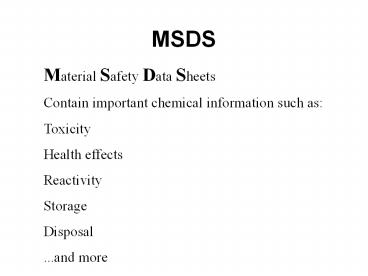MSDS - PowerPoint PPT Presentation
Title:
MSDS
Description:
MSDS Material Safety Data Sheets Contain important chemical information such as: Toxicity Health effects Reactivity Storage Disposal...and more More Information All ... – PowerPoint PPT presentation
Number of Views:370
Avg rating:3.0/5.0
Title: MSDS
1
MSDS
Material Safety Data Sheets Contain important
chemical information such as Toxicity Health
effects Reactivity Storage Disposal ...and more
2
More Information
- All pertinent information about the physical
properties of a chemical such as odor, color,
melting and/or boiling point, density, etc. - All health risks and appropriate precautions for
handling a chemical such as the use of gloves,
hood, lab coat, special breathing apparatus, etc.
3
Who is an MSDS for?
- For those working with the material in a
occupational fashion - Employees who work with chemicals
- Employees who need to know the proper storage
of chemicals - Emergency responders (fire-fighters, haz mat
teams, etc.) - Not for consumers
- Example An MSDS for paint is not necessary for
someone who uses a can of paint once a year, but
is important to someone who paints in a confined
area for a living - What does an MSDS look like?
4
Why Do We Keep MSDS Sheets?
The U.S. Government's Occupational Safety and
Health Administration (OSHA) is responsible for
the Hazard Communication Standard 29 CFR
1910.1200. The purpose of this standard is to
ensure that the hazards of all chemicals produced
or imported are evaluated, and that information
concerning their hazards is transmitted to
employers and employees. This transmittal of
information is to be accomplished by means of
comprehensive hazard communication programs,
which are to include container labeling and other
forms of warning, material safety data sheets and
employee training. I.e. Because companies are
required to
5
MSDS of Acetic Acid
- Acetic acid comes in numerous forms depending on
the concentration of the acid in water. For
instance, we use 4.5 acetic acid in making
salad dressing (it is commonly called vinegar). - Acetic acid is also sold in more concentrated
formulations for use in the chemistry laboratory.
Glacial acetic acid is 17.4 M and is considered
100. It is the strongest form for the acid and
would kill you if you drank it. - The MSDS for glacial acetic acid would be
different from that for vinegar but the names
acetic acid are the same, the chemical formulas
are the same, the formula weights are the same,
etc.































